cooling Hyundai Accent 2005 Owner's Manual
[x] Cancel search | Manufacturer: HYUNDAI, Model Year: 2005, Model line: Accent, Model: Hyundai Accent 2005Pages: 219, PDF Size: 7.07 MB
Page 13 of 219
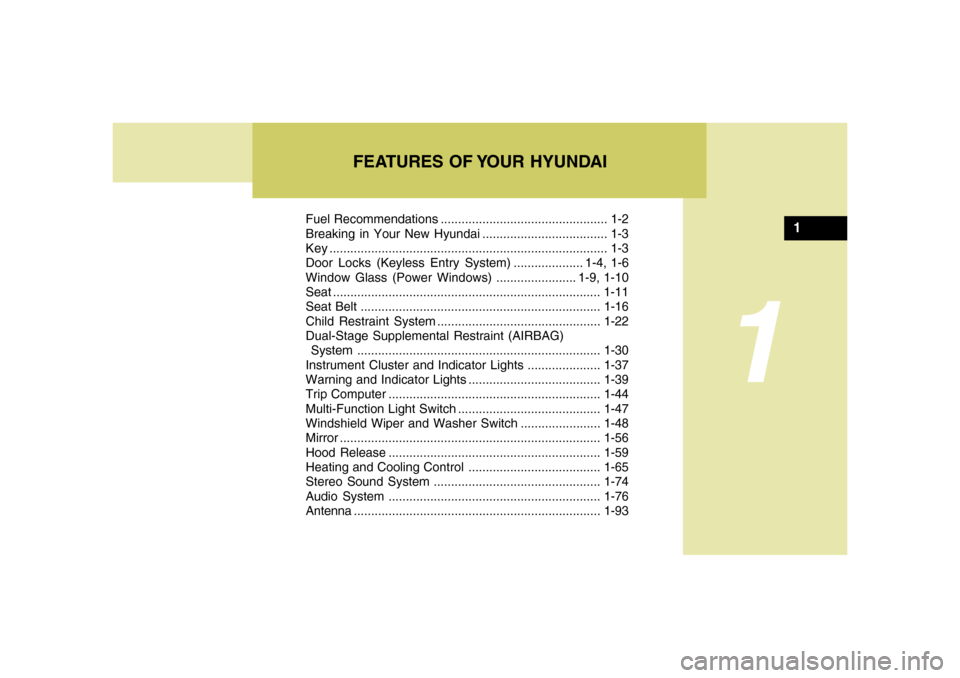
FEATURES OF YOUR HYUNDAI
1
Fuel Recommendations ................................................ 1-2
Breaking in Your New Hyundai .................................... 1-3
Key ................................................................................ 1-3
Door Locks (Keyless Entry System) .................... 1-4, 1-6
Window Glass (Power Windows) ....................... 1-9, 1-10
Seat ............................................................................. 1-11
Seat Belt.....................................................................1-16
Child Restraint System...............................................1-22
Dual-Stage Supplemental Restraint (AIRBAG)
System......................................................................1-30
Instrument Cluster and Indicator Lights .....................1-37
Warning and Indicator Lights ......................................1-39
Trip Computer.............................................................1-44
Multi-Function Light Switch .........................................1-47
Windshield Wiper and Washer Switch.......................1-48
Mirror...........................................................................1-56
Hood Release.............................................................1-59
Heating and Cooling Control ......................................1-65
Stereo Sound System................................................1-74
Audio System.............................................................1-76
Antenna.......................................................................1-93
1
Page 55 of 219
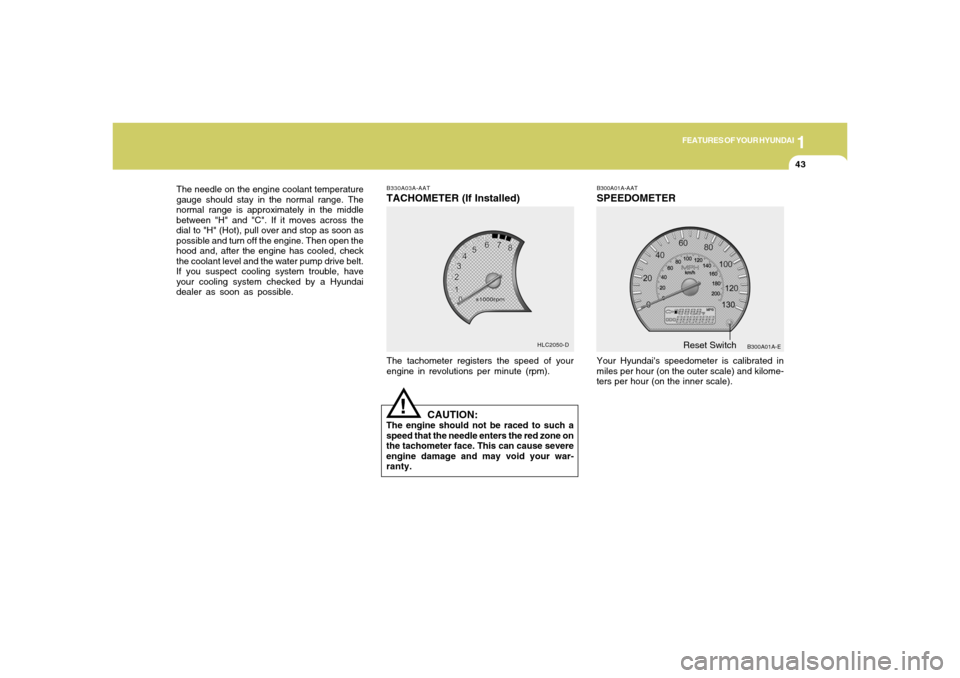
1
FEATURES OF YOUR HYUNDAI
43
B330A03A-AATTACHOMETER (If Installed)The tachometer registers the speed of your
engine in revolutions per minute (rpm).
B300A01A-AATSPEEDOMETERYour Hyundai's speedometer is calibrated in
miles per hour (on the outer scale) and kilome-
ters per hour (on the inner scale).
B300A01A-E HLC2050-D
Reset Switch
CAUTION:
The engine should not be raced to such a
speed that the needle enters the red zone on
the tachometer face. This can cause severe
engine damage and may void your war-
ranty.
!
The needle on the engine coolant temperature
gauge should stay in the normal range. The
normal range is approximately in the middle
between "H" and "C". If it moves across the
dial to "H" (Hot), pull over and stop as soon as
possible and turn off the engine. Then open the
hood and, after the engine has cooled, check
the coolant level and the water pump drive belt.
If you suspect cooling system trouble, have
your cooling system checked by a Hyundai
dealer as soon as possible.
Page 77 of 219
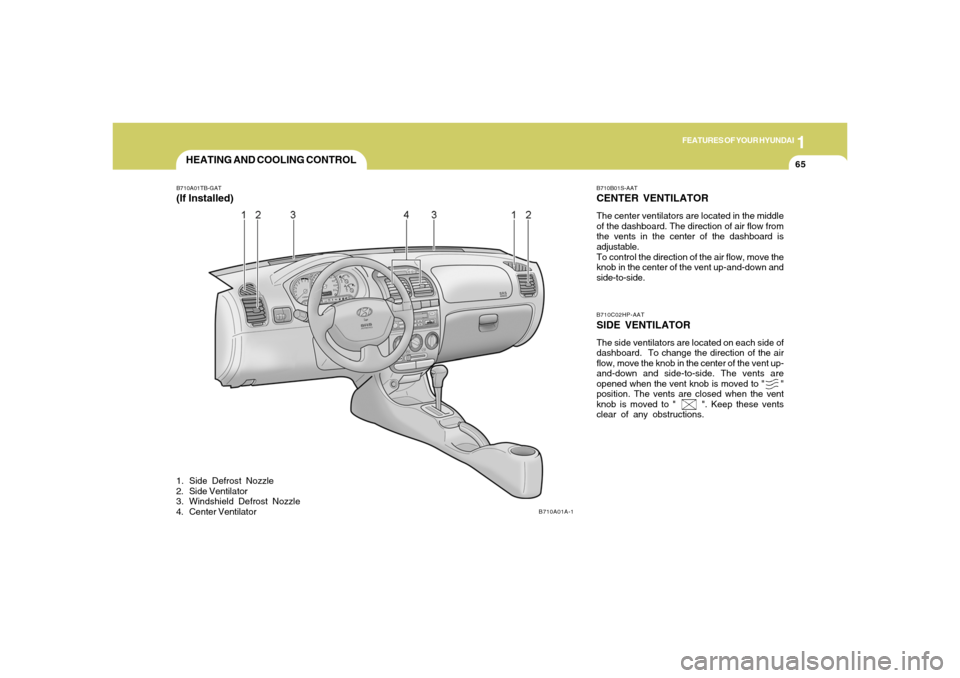
1
FEATURES OF YOUR HYUNDAI
65
HEATING AND COOLING CONTROLB710A01TB-GAT(If Installed)
B710A01A-1
1. Side Defrost Nozzle
2. Side Ventilator
3. Windshield Defrost Nozzle
4. Center Ventilator
B710B01S-AATCENTER VENTILATORThe center ventilators are located in the middle
of the dashboard. The direction of air flow from
the vents in the center of the dashboard is
adjustable.
To control the direction of the air flow, move the
knob in the center of the vent up-and-down and
side-to-side.B710C02HP-AATSIDE VENTILATORThe side ventilators are located on each side of
dashboard. To change the direction of the air
flow, move the knob in the center of the vent up-
and-down and side-to-side. The vents are
opened when the vent knob is moved to " "
position. The vents are closed when the vent
knob is moved to " ". Keep these vents
clear of any obstructions.
Page 78 of 219
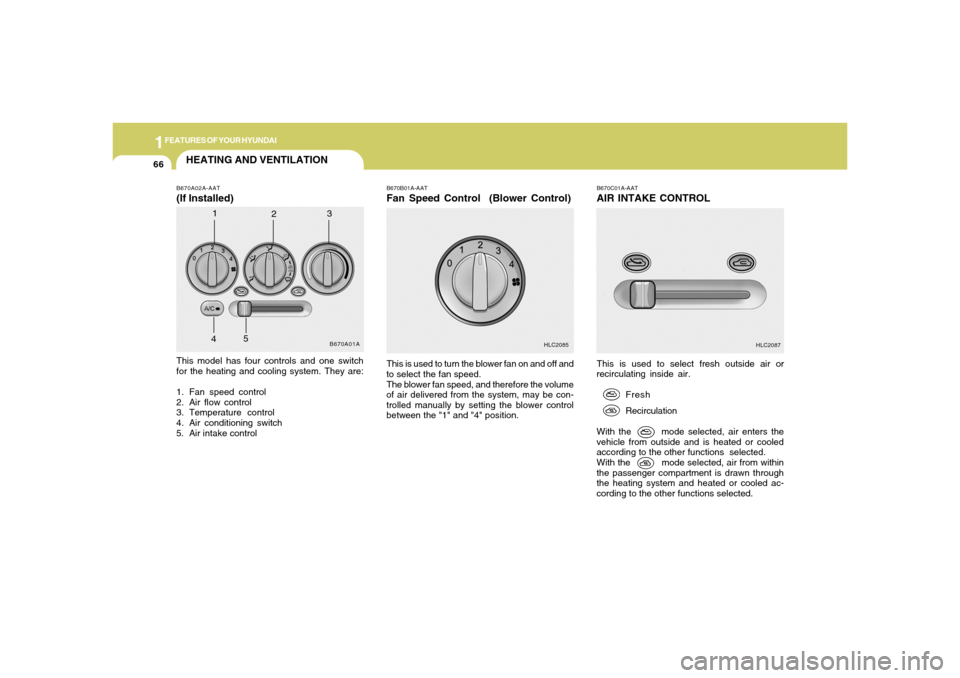
1FEATURES OF YOUR HYUNDAI66
HEATING AND VENTILATION
This is used to select fresh outside air or
recirculating inside air.
Fresh
Recirculation
With the mode selected, air enters the
vehicle from outside and is heated or cooled
according to the other functions selected.
With the mode selected, air from within
the passenger compartment is drawn through
the heating system and heated or cooled ac-
cording to the other functions selected.B670C01A-AATAIR INTAKE CONTROL
This model has four controls and one switch
for the heating and cooling system. They are:
1. Fan speed control
2. Air flow control
3. Temperature control
4. Air conditioning switch
5. Air intake control
B670B01A-AATFan Speed Control (Blower Control)This is used to turn the blower fan on and off and
to select the fan speed.
The blower fan speed, and therefore the volume
of air delivered from the system, may be con-
trolled manually by setting the blower control
between the "1" and "4" position.
B670A02A-AAT(If Installed)
B670A01A
1
23
4
HLC2085
HLC2087
5
Page 81 of 219
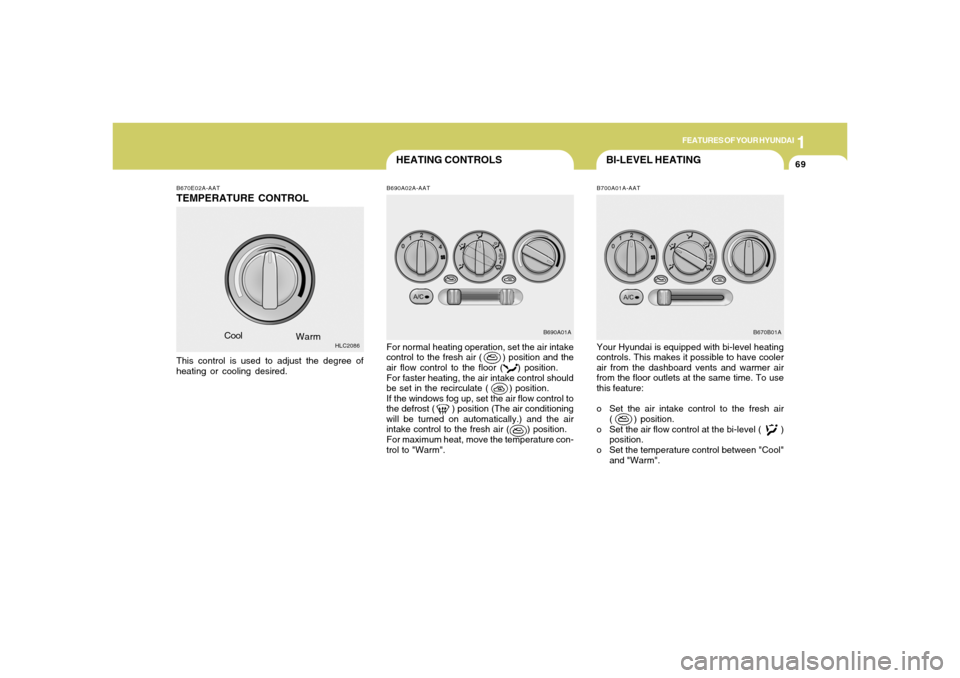
1
FEATURES OF YOUR HYUNDAI
69
BI-LEVEL HEATING
HEATING CONTROLSB690A02A-AAT B670E02A-AAT
TEMPERATURE CONTROL
Cool
Warm
This control is used to adjust the degree of
heating or cooling desired.
HLC2086
For normal heating operation, set the air intake
control to the fresh air ( ) position and the
air flow control to the floor ( ) position.
For faster heating, the air intake control should
be set in the recirculate ( ) position.
If the windows fog up, set the air flow control to
the defrost ( ) position (The air conditioning
will be turned on automatically.) and the air
intake control to the fresh air ( ) position.
For maximum heat, move the temperature con-
trol to "Warm".
B700A01A-AATYour Hyundai is equipped with bi-level heating
controls. This makes it possible to have cooler
air from the dashboard vents and warmer air
from the floor outlets at the same time. To use
this feature:
o Set the air intake control to the fresh air
( ) position.
o Set the air flow control at the bi-level ( )
position.
o Set the temperature control between "Cool"
and "Warm".
B690A01A
B670B01A
Page 82 of 219
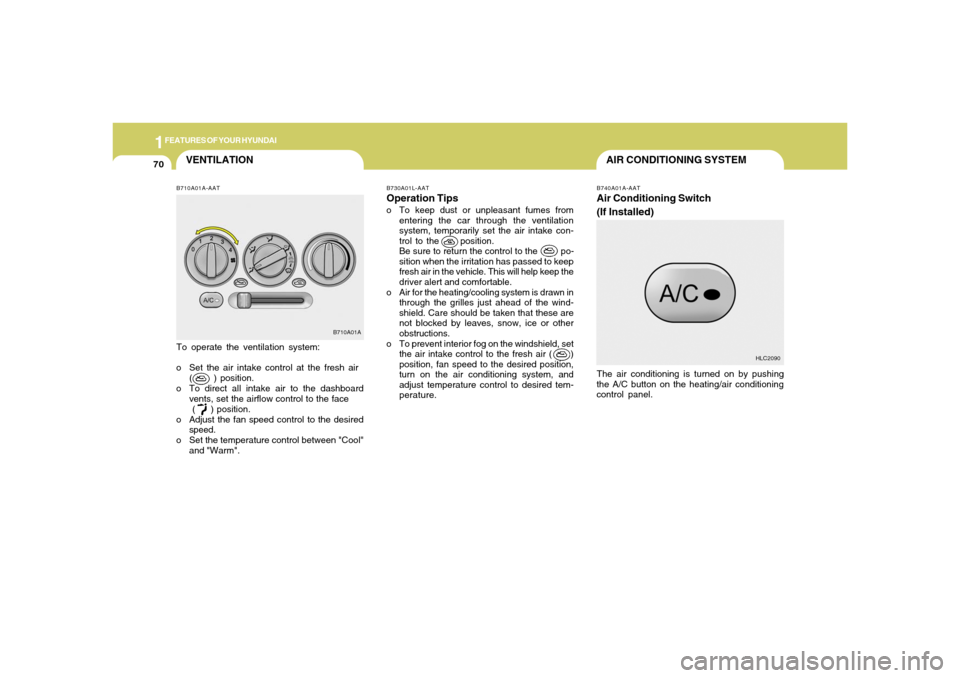
1FEATURES OF YOUR HYUNDAI70
VENTILATION
B730A01L-AATOperation Tipso To keep dust or unpleasant fumes from
entering the car through the ventilation
system, temporarily set the air intake con-
trol to the position.
Be sure to return the control to the po-
sition when the irritation has passed to keep
fresh air in the vehicle. This will help keep the
driver alert and comfortable.
o Air for the heating/cooling system is drawn in
through the grilles just ahead of the wind-
shield. Care should be taken that these are
not blocked by leaves, snow, ice or other
obstructions.
o To prevent interior fog on the windshield, set
the air intake control to the fresh air ( )
position, fan speed to the desired position,
turn on the air conditioning system, and
adjust temperature control to desired tem-
perature.
B740A01A-AATAir Conditioning Switch
(If Installed)The air conditioning is turned on by pushing
the A/C button on the heating/air conditioning
control panel.
B710A01A-AATTo operate the ventilation system:
o Set the air intake control at the fresh air
( ) position.
o To direct all intake air to the dashboard
vents, set the airflow control to the face
( ) position.
o Adjust the fan speed control to the desired
speed.
o Set the temperature control between "Cool"
and "Warm".
B710A01A
HLC2090
AIR CONDITIONING SYSTEM
Page 83 of 219
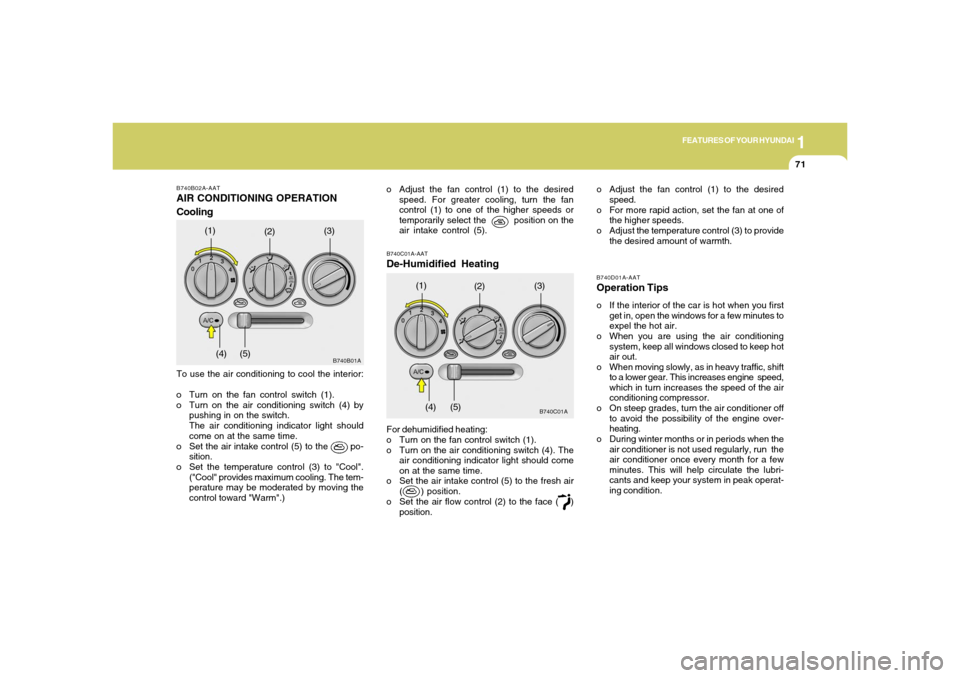
1
FEATURES OF YOUR HYUNDAI
71
B740B02A-AATAIR CONDITIONING OPERATION
CoolingTo use the air conditioning to cool the interior:
o Turn on the fan control switch (1).
o Turn on the air conditioning switch (4) by
pushing in on the switch.
The air conditioning indicator light should
come on at the same time.
o Set the air intake control (5) to the po-
sition.
o Set the temperature control (3) to "Cool".
("Cool" provides maximum cooling. The tem-
perature may be moderated by moving the
control toward "Warm".)
(1)
(2)(3)
(4) (5)
B740D01A-AATOperation Tipso If the interior of the car is hot when you first
get in, open the windows for a few minutes to
expel the hot air.
o When you are using the air conditioning
system, keep all windows closed to keep hot
air out.
o When moving slowly, as in heavy traffic, shift
to a lower gear. This increases engine speed,
which in turn increases the speed of the air
conditioning compressor.
o On steep grades, turn the air conditioner off
to avoid the possibility of the engine over-
heating.
o During winter months or in periods when the
air conditioner is not used regularly, run the
air conditioner once every month for a few
minutes. This will help circulate the lubri-
cants and keep your system in peak operat-
ing condition.
B740C01A-AATDe-Humidified HeatingFor dehumidified heating:
o Turn on the fan control switch (1).
o Turn on the air conditioning switch (4). The
air conditioning indicator light should come
on at the same time.
o Set the air intake control (5) to the fresh air
( ) position.
o Set the air flow control (2) to the face ( )
position.
B740C01A
(1)
(2)(3)
(4) (5)
o Adjust the fan control (1) to the desired
speed. For greater cooling, turn the fan
control (1) to one of the higher speeds or
temporarily select the position on the
air intake control (5).o Adjust the fan control (1) to the desired
speed.
o For more rapid action, set the fan at one of
the higher speeds.
o Adjust the temperature control (3) to provide
the desired amount of warmth.
B740B01A
Page 120 of 219

2
DRIVING YOUR HYUNDAI
14
C160D01A-AATCheck Battery and CablesWinter puts additional burdens on the battery
system. Visually inspect the battery and cables
as described in Section 6. The level of charge in
your battery can be checked by your Hyundai
dealer or a service station.
C160E01A-AATChange to "Winter Weight" Oil if
NecessaryIn some climates it is recommended that a lower
viscosity "winter weight" oil be used during cold
weather. See Section 9 for recommendations. If
you aren't sure what weight oil you should use,
consult your Hyundai dealer.
C160C01A-AATUse High Quality Ethylene Glycol
CoolantYour Hyundai is delivered with high quality eth-
ylene glycol coolant in the cooling system. It is
the only type of coolant that should be used
because it helps prevent corrosion in the cooling
system, lubricates the water pump and prevents
freezing. Be sure to replace or replenish your
coolant in accordance with the maintenance
schedule in Section 5. Before winter, have your
coolant tested to assure that its freezing point is
sufficient for the temperatures anticipated dur-
ing the winter.
C160H01A-AATUse Approved Anti-Freeze in Window
Washer SystemTo keep the water in the window washer system
from freezing, add an approved anti-freeze so-
lution in accordance with instructions on the
container. Window washer anti-freeze is avail-
able from Hyundai dealers and most auto parts
outlets. Do not use engine coolant or other types
of anti-freeze as these may damage the finish.
C160F01A-AATCheck Spark Plugs and Ignition
SystemInspect your spark plugs as described in Sec-
tion 6 and replace them if necessary. Also
check all ignition wiring and components to be
sure they are not cracked, worn or damaged in
any way.
C160G01A-AATTo Keep Locks from FreezingTo keep the locks from freezing, squirt an ap-
proved de-icer fluid or glycerine into the key
opening. If a lock is covered with ice, squirt it
with an approved de-icing fluid to remove the
ice. If the lock is frozen internally, you may be
able to thaw it out by using a heated key. Handle
the heated key with care to avoid injury.
Page 130 of 219
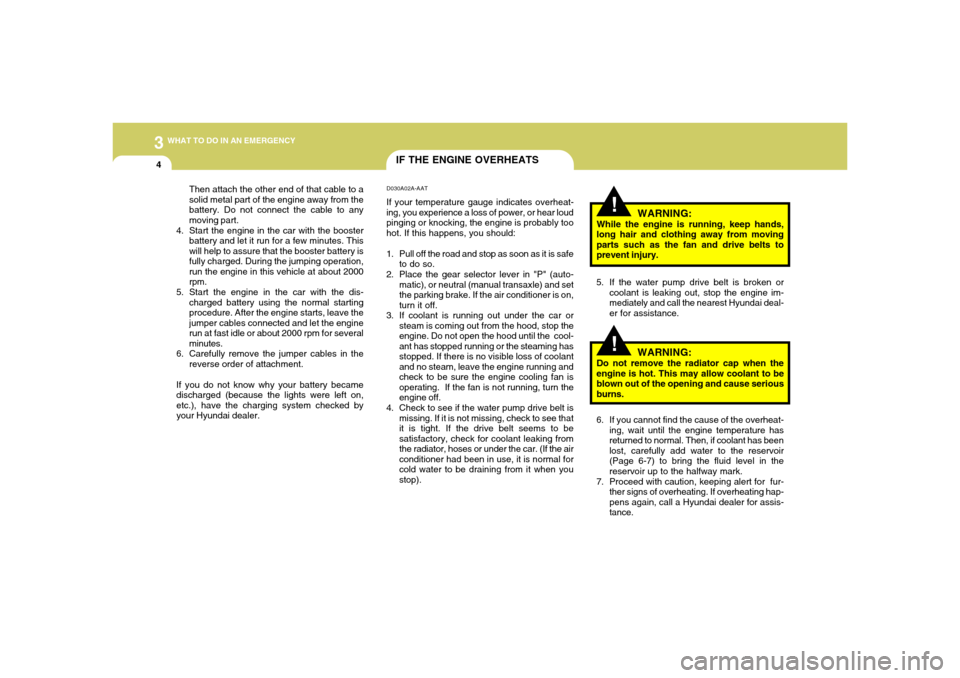
34WHAT TO DO IN AN EMERGENCY
IF THE ENGINE OVERHEATS
!!
WARNING:
While the engine is running, keep hands,
long hair and clothing away from moving
parts such as the fan and drive belts to
prevent injury.
D030A02A-AATIf your temperature gauge indicates overheat-
ing, you experience a loss of power, or hear loud
pinging or knocking, the engine is probably too
hot. If this happens, you should:
1. Pull off the road and stop as soon as it is safe
to do so.
2. Place the gear selector lever in "P" (auto-
matic), or neutral (manual transaxle) and set
the parking brake. If the air conditioner is on,
turn it off.
3. If coolant is running out under the car or
steam is coming out from the hood, stop the
engine. Do not open the hood until the cool-
ant has stopped running or the steaming has
stopped. If there is no visible loss of coolant
and no steam, leave the engine running and
check to be sure the engine cooling fan is
operating. If the fan is not running, turn the
engine off.
4. Check to see if the water pump drive belt is
missing. If it is not missing, check to see that
it is tight. If the drive belt seems to be
satisfactory, check for coolant leaking from
the radiator, hoses or under the car. (If the air
conditioner had been in use, it is normal for
cold water to be draining from it when you
stop).5. If the water pump drive belt is broken or
coolant is leaking out, stop the engine im-
mediately and call the nearest Hyundai deal-
er for assistance.
WARNING:
Do not remove the radiator cap when the
engine is hot. This may allow coolant to be
blown out of the opening and cause serious
burns.
6. If you cannot find the cause of the overheat-
ing, wait until the engine temperature has
returned to normal. Then, if coolant has been
lost, carefully add water to the reservoir
(Page 6-7) to bring the fluid level in the
reservoir up to the halfway mark.
7. Proceed with caution, keeping alert for fur-
ther signs of overheating. If overheating hap-
pens again, call a Hyundai dealer for assis-
tance. Then attach the other end of that cable to a
solid metal part of the engine away from the
battery. Do not connect the cable to any
moving part.
4. Start the engine in the car with the booster
battery and let it run for a few minutes. This
will help to assure that the booster battery is
fully charged. During the jumping operation,
run the engine in this vehicle at about 2000
rpm.
5. Start the engine in the car with the dis-
charged battery using the normal starting
procedure. After the engine starts, leave the
jumper cables connected and let the engine
run at fast idle or about 2000 rpm for several
minutes.
6. Carefully remove the jumper cables in the
reverse order of attachment.
If you do not know why your battery became
discharged (because the lights were left on,
etc.), have the charging system checked by
your Hyundai dealer.
Page 131 of 219
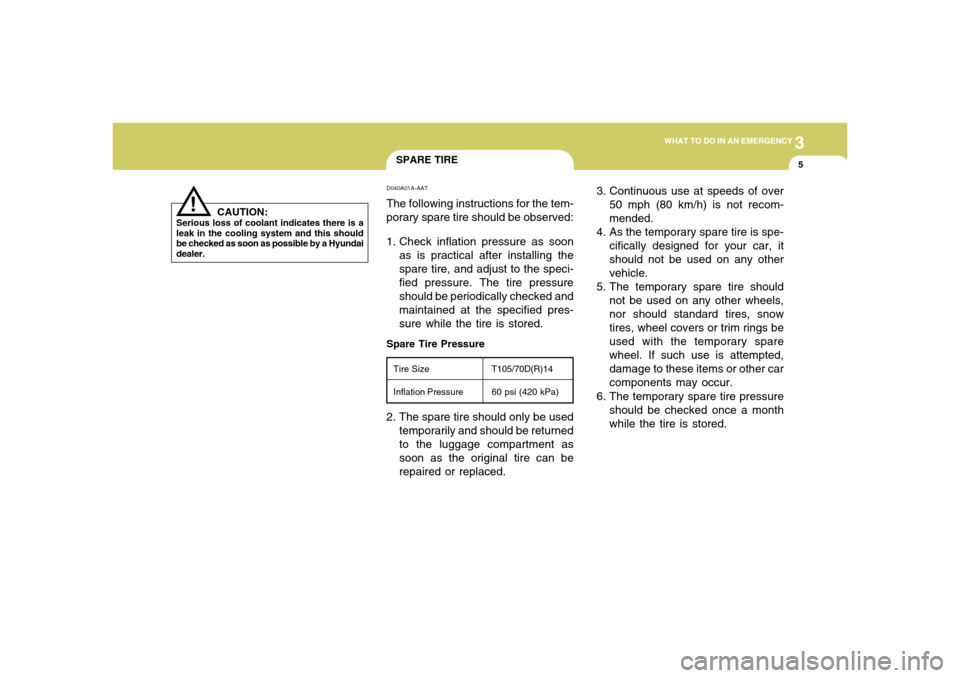
3
WHAT TO DO IN AN EMERGENCY
5
SPARE TIRE
Spare Tire PressureD040A01A-AATThe following instructions for the tem-
porary spare tire should be observed:
1. Check inflation pressure as soon
as is practical after installing the
spare tire, and adjust to the speci-
fied pressure. The tire pressure
should be periodically checked and
maintained at the specified pres-
sure while the tire is stored.
!
Tire Size
Inflation Pressure
T105/70D(R)14
60 psi (420 kPa)
CAUTION:
Serious loss of coolant indicates there is a
leak in the cooling system and this should
be checked as soon as possible by a Hyundai
dealer.
3. Continuous use at speeds of over
50 mph (80 km/h) is not recom-
mended.
4. As the temporary spare tire is spe-
cifically designed for your car, it
should not be used on any other
vehicle.
5. The temporary spare tire should
not be used on any other wheels,
nor should standard tires, snow
tires, wheel covers or trim rings be
used with the temporary spare
wheel. If such use is attempted,
damage to these items or other car
components may occur.
6. The temporary spare tire pressure
should be checked once a month
while the tire is stored. 2. The spare tire should only be used
temporarily and should be returned
to the luggage compartment as
soon as the original tire can be
repaired or replaced.